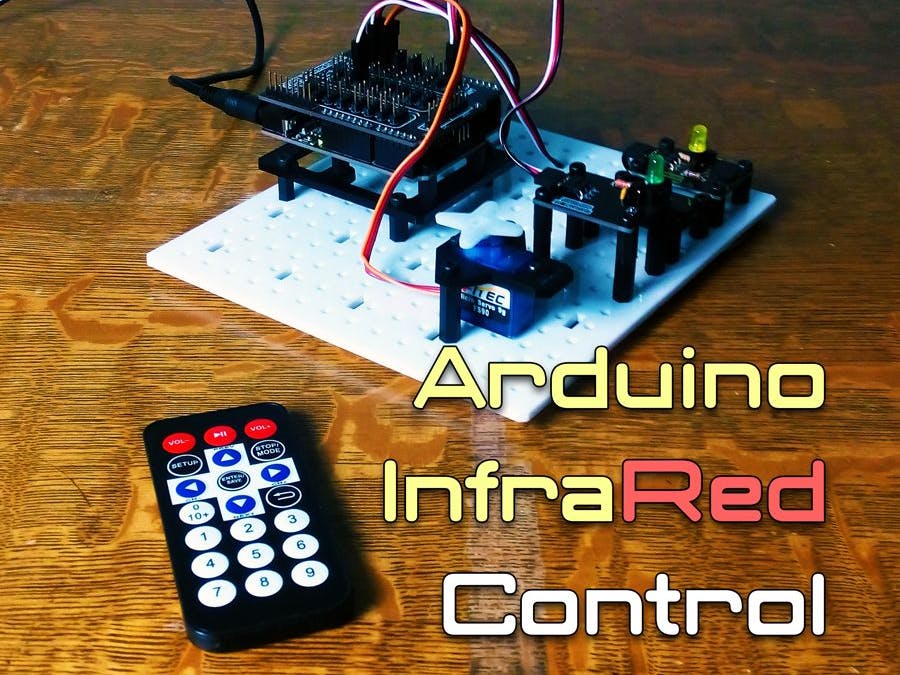Want a low cost solution to wirelessly control your next project? You can use an IR Receiver and an old remote you have lying around the house! In this tutorial, we will walk you through figuring out your remote's protocol, getting the hex codes for button presses, and using those button presses to control some LEDs and a servo! It looks a bit scary at first, but it's really simple!
Step 1: Project PartsWe will be using a RobotGeek IR Receiver with a Geekduino and sensor shield. You can use any parts you like, but the diagrams will assume you have these parts. The LEDs and Servo are to show just a few ways you can use IR input. They are not fully necessary to complete this demonstration, but serve to illustrate the functionality well.
Step 2: Find your Remote's ProtocolThe first step to using any infrared controller is to find its protocol. The most common protocols are NEC and SONY. Virtually every remote made by Sony uses the same protocol, and most unbranded or generic controllers use NEC, but it's always a good idea to check the protocol. We've put everything together to make it as simple as possible to get started.
Hook up your Arduino according to the diagram.
Grab the RobotGeek Libraries and Tools, and drop it in your Arduino folder.
Start up the Arduino IDE and navigate to:
File → Examples → IRLib → IRfreqScout
Load the sketch onto your Arduino.
Open the serial monitor and get your remote ready.
The Serial Monitor should say Send a signal repeatedly. We will report averages and statistics.
Press a button on the remote. You may want to press the same button a couple times. You will get a readout like the following:
Samples=1
Decoded Sony(2): Value:A8B92 (20 bits)
Raw samples(42): Gap:300
Head: m2300 s650
0:m1100 s650 1:m550 s650 2:m1100 s700 3:m500 s650
4:m1100 s700 5:m500 s650 6:m600 s600 7:m600 s600
8:m1100 s650 9:m500 s700 10:m1100 s650 11:m1100 s700
12:m1100 s650 13:m500 s700 14:m500 s650 15:m1100 s700
16:m550 s600 17:m600 s600 18:m1100 s650 19:m550
Extent=31250
Mark min:500 max:1100
Space min:600 max:700
# Low High Avg.
Mark 20 500 1100 792
Space 19 600 700 655
Marks # Low High Avg.
Above Avg 9 1100 1100 1100
Belows Avg. 11 500 600 540
Spaces # Low High Avg.
Above Avg. 6 700 700 700
Below Avg. 13 600 650 634
Ratios Below Above
Head Mark 4.26 2.09
Head Space 1.03 0.93
Mark Above/Below= 2.04
Space Above/Below= 1.10
The main thing to pay attention to at this step is where it says: Decoded Sony(2): Value:A8B92 (20 bits)
. This tells you the Protocol and the Hex value of the button you pressed. Try pressing different buttons, and you'll see the Value change. If you try a remote with a different protocol, you might get a result such as Decoded NEC(1): Value:FF02FD (32 bits)
. This one tells you that you're using a remote that utilizes the NEC protocol. You'll need to know which protocol you're using for any project that uses Infrared, so keep track of this.
You could get all the button presses from the last sketch we loaded, but that would take a long time, as it loads much more information than we need and searches for the protocol every cycle. To check for ONLY the Hex values being transmitted to your receiver, open this sketch in the Arduino IDE:
File → Examples → IRLib → IRhexSerial
You'll need to put the protocol in for your remote in line 11:
#define MY_PROTOCOL NEC
If you're using a remote that was defined as something other than NEC, replace NEC
with the matching protocol. The protocols are as follows:
UNKNOWNNECSONYRC5RC6PANASONIC_OLDJVCNECX
Once you have your protocol set, simply load the sketch onto your board and open the Serial Monitor.
Press some buttons, and you will receive hex values! Note that if you are using a NEC remote, holding the button down will give you the value FFFFFFFF
. This is normal for NEC remotes, and is handled in code. You can either systematically press the buttons on the remote, keeping track in a spreadsheet which buttons give which hex values, or you can use the wizard utility in the next step to grab the hex values for your remote.
The next sketch we'll have you load is the IR Remote Wizard. You can find it under:
File → Examples → IRLib → IRremoteWizard
Load the sketch on to your board, open the serial monitor, set it to No line ending
in the new line / carriage return dropdown, and follow the prompts.
The first prompt will ask you to press buttons on your remote. This step automatically finds the protocol of your remote on receipt of a signal. Type 1 in the bar at the top and press Enter on your keyboard or click Send in the top right corner.
The next lines that will show up say:
Protocol Section Finished. Start Button reading.
Press the button for RIGHT_BUTTON
Follow the instruction and press the corresponding button on your remote. Upon receipt of the button press, the serial monitor should now read:
Button Found:3EB92 Send any character on the serial monitor to continue
Follow the instruction, repeating the process of typing a character into the top bar and sending it, followed by pressing the corresponding button on your remote. This will continue through asking you for directional buttons, a select button, numerals 0-9, and two buttons of your choosing.
Once you have completed this process, it will spit out a block of code that looks like this:
IR Code Block:
const unsigned long MY_PROTOCOL = SONY;
const unsigned long RIGHT_BUTTON = 0x9EB92;
const unsigned long LEFT_BUTTON = 0xDEB92;
const unsigned long UP_BUTTON = 0x9EB92;
const unsigned long DOWN_BUTTON = 0x5EB92;
const unsigned long SELECT_BUTTON = 0xD0B92;
const unsigned long ONE_BUTTON = 0xB92;
const unsigned long TWO_BUTTON = 0x80B92;
const unsigned long THREE_BUTTON = 0x40B92;
const unsigned long FOUR_BUTTON = 0xC0B92;
const unsigned long FIVE_BUTTON = 0x20B92;
const unsigned long SIX_BUTTON = 0xA0B92;
const unsigned long SEVEN_BUTTON = 0x60B92;
const unsigned long EIGHT_BUTTON = 0xE0B92;
const unsigned long NINE_BUTTON = 0x10B92;
const unsigned long ZERO_BUTTON = 0x90B92;
const unsigned long SPECIAL_1_BUTTON = 0x481;
const unsigned long SPECIAL_2_BUTTON = 0xC81;
Copy this code from your serial monitor, you will need it.
Step 5: Insert your hex codes in the demo sketchNow we're getting to the good stuff. So you've got your code for the remotes ready to go, and you need a place to put it. Open:
File → Sketchbook → RobotGeekSketches → Demos → IR → IRcontrolBasics
You'll see at the top two tabs, one marked IRcontrolBasics
, and one marked remotes.h
. Click on remotes.h
and you should see a list of remote definitions, followed by code that looks very similar to the code you just made. You can replace the similar code of one of the remotes or add a definition and #elif
statement. The main things to consider are:
1.) The definition of the remote you're using. On line 1, you will see:
#define REMOTE_TYPE MINI_REMOTE_1
Change MINI_REMOTE_1
to the name of the remote you would like to use.
2.) The #elif statement. Before the #endif
statement, you can add your remote with a line like the following:
#elif REMOTE_TYPE == MY_REMOTE_NAME_HERE
followed by the list of const unsigned long
s you got from the wizard.
3.) The const unsigned long integers. You can add any number of buttons that exist on your remote by adding definitions to this list with names corresponding to the hex values you received in the earlier steps preceded by 0x
, to indicate that it is a hex value.
Hook up your parts according to the diagram.
Now upload the sketch! You can open the Serial Monitor if you'd like to take a look at the input from the remote. Controlling the sketch works as follows:
- Pressing Left or Right turns the servo
- Pressing Up or Down increases or decreases the brightness of LED 2
- Pressing 1 or 2 turns on or off LED 1
- Pressing Special Button 1 or Special Button 2 decreases or increases the speed of the servo
This should give you a pretty good foundation to work off of for a wide variety of projects!
Step 7: You're done!Now you have a jumping off point for integrating Infrared Control into your next project! What are you going to make? We'd love to see what you come up with!








_ztBMuBhMHo.jpg?auto=compress%2Cformat&w=48&h=48&fit=fill&bg=ffffff)






Comments
Please log in or sign up to comment.